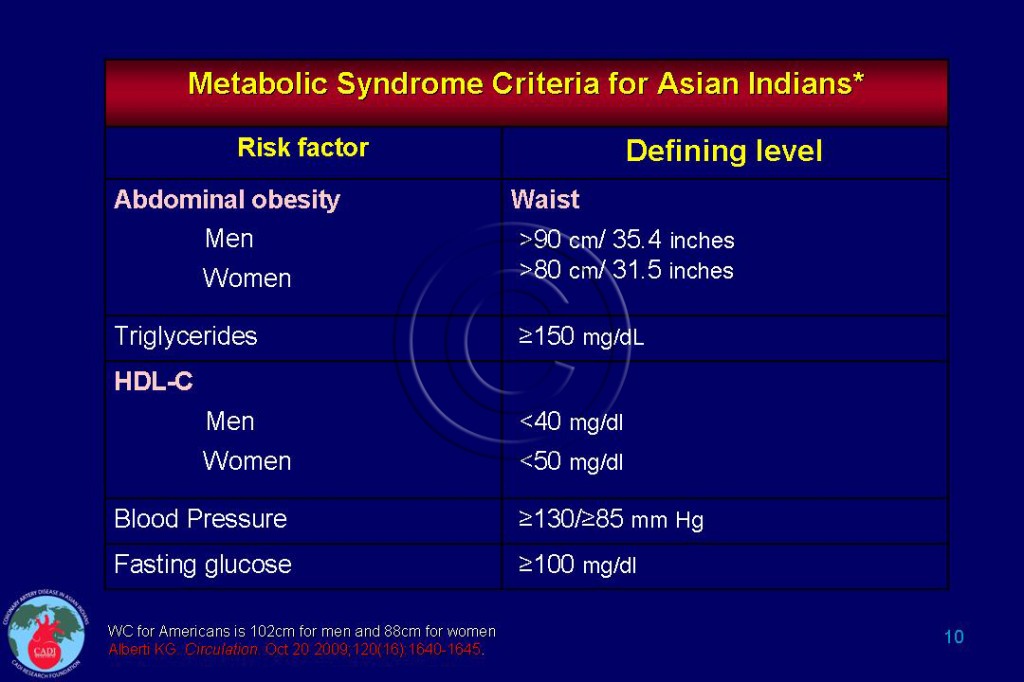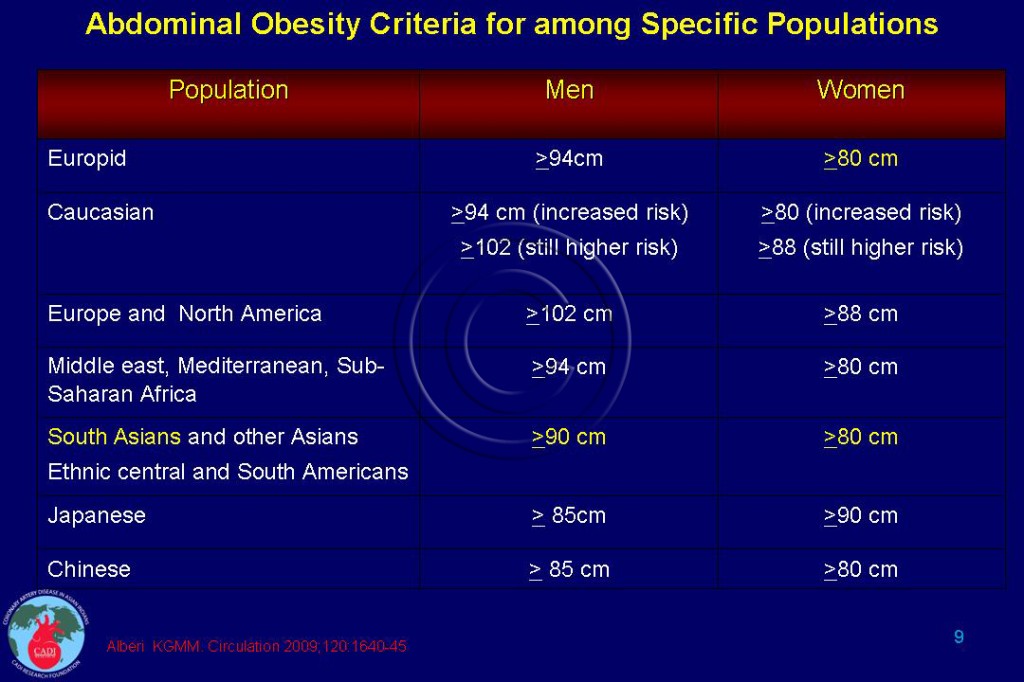Metabolic Syndrome Criteria
- The 5 key components of metabolic syndrome (MS) are: abdominal obesity, high triglycerides, low HDL, prehypertension (above normal blood pressure), and prediabetes (above normal blood sugar). The presence of any three of these components qualifies for the diagnosis of metabolic syndrome (Table 010).
- Although both International Diabetes Federation (IDF) and National Cholesterol Education Program-Adult Treatment Panel (NCEP- ATP III) criteria incorporate abdominal obesity as a component of MS, they differ in their emphasis and the cut points of waist circumference (WC) ─the yardstick of abdominal obesity.
- Abdominal obesity is an “essential” component according to IDF, but is an “optional” component according to the NCEP. Furthermore, among whites, cut point for WC is 8 cm lower with IDF than for NCEP, in both men and women.1
- The prevalence of abdominal obesity in the US population increases from 40% to 60% in men and from 63% to 82% in women by substituting the IDF WC for the NCEP WC.1, 2 Since 70% of the US population has abdominal obesity by IDF criteria, the requirement of abdominal obesity does not affect the prevalence of MS in the US population significantly ─ 34% by NCEP and 40% with IDF criteria.1
- Similarly, the prevalence of the MS increases from 25% to 28% when using the low (94/80) and the high (102/88) WC cut-off points, respectively in Luxemburg.3
- In sharp contrast the prevalence of metabolic syndrome may be underestimated by 25-50% if the South Asian specific WC criteria lower (94/80cm) for abdominal obesity are not used.1, 4-6
- A Joint Interim Statement of the International Diabetes Federation Task Force on Epidemiology and Prevention; National Heart, Lung, and Blood Institute; American Heart Association; World Heart Federation; International Atherosclerosis Society; and International Association for the Study of Obesity has recommended using ethnic, gender and country specific criteria for abdominal obesity as shown in Table 009.4
- The new global definition of metabolic syndrome has streamlined the differences in measurements in waist circumference between NCEP and IDF.
- Now the criteria for elevated WC are based on population and country specific definitions. Furthermore abdominal obesity is no longer a mandatory component. Three abnormal findings out of 5 would qualify a person for the metabolic syndrome.4
- Abdominal obesity is considered present if the waist girth is greater than 90 cm for South Asian men (as opposed to 102 cm in whites) and more than 80 cm for South Asian women (as opposed to 102 cm in whites).
Sources
1. Enas EA, Mohan V, Deepa M, Farooq S, Pazhoor S, Chennikkara H. The metabolic syndrome and dyslipidemia among Asian Indians: a population with high rates of diabetes and premature coronary artery disease. Journal of the cardiometabolic syndrome. Fall 2007;2(4):267-275.
2. Cheung BM, Ong KL, Man YB, Wong LY, Lau CP, Lam KS. Prevalence of the metabolic syndrome in the United States National Health and Nutrition Examination Survey 1999-2002 according to different defining criteria. Journal of clinical hypertension (Greenwich, Conn. Aug 2006;8(8):562-570.
3. Alkerwi A, Donneau AF, Sauvageot N, et al. Prevalence of the metabolic syndrome in Luxembourg according to the Joint Interim statement definition estimated from the ORISCAV-LUX study. BMC Public Health. Jan 4 2011;11(1):4.
4. Alberti KG, Eckel RH, Grundy SM, et al. Harmonizing the metabolic syndrome: a joint interim statement of the International Diabetes Federation Task Force on Epidemiology and Prevention; National Heart, Lung, and Blood Institute; American Heart Association; World Heart Federation; International Atherosclerosis Society; and international association for the Study of Obesity. Circulation. Oct 20 2009;120(16):1640-1645.
5. Enas EA, Singh V, Gupta R, Patel R, et al. Recommendations of the Second Indo-US Health Summit for the prevention and control of cardiovascular disease among Asian Indians. Indian heart journal. 2009;61:265-74.
6. Ervin RB. Prevalence of metabolic syndrome among adults 20 years of age and over, by sex, age, race and ethnicity, and body mass index: United States, 2003-2006. Natl Health Stat Report. May 5 2009(13):1-7.



